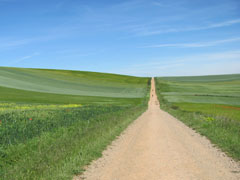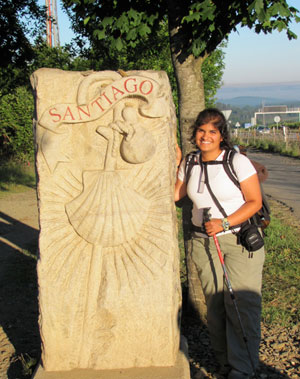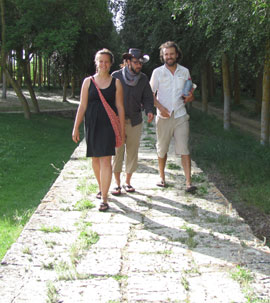A Study-Away Story
By Jennifer Ghandhi
After she graduated this spring with degrees in economics and philosophy—and before she moved north to begin an M.D./Ph.D. program at the University of Chicago—honors student Jennifer Ghandhi had one last UAB experience. In the company of eight other UAB students; foreign languages professor John K. Moore, Ph.D.; and UAB alumnus Luis Robledo, Ghandhi flew to Spain to hike a portion of the ancient pilgrim’s trail known as the Camino de Santiago. The Camino converges on the Spanish town of Santiago de Compostela from points across Europe.
 |
The Camino de Santiago |
Up until the point we left for the airport, I found myself thumbing away at my phone: updating my Facebook status, checking last-minute e-mails, and sending goodbye texts. I was about to commit to a month-long sabbatical from digital communication, and the pocket where my phone usually resided felt uncharacteristically light. Boarding a plane full of headphone-clad passengers confirmed that the most missed of my beloved gadgets would likely be my iPod.
As our journey began, my thoughts wandered toward our distant destination. It would take five weeks on foot to reach Santiago de Compostela, the sacred city where the remains of St. James the apostle were held. Four years after first hearing about the pilgrimage in Professor John Moore’s seminar at UAB, I was finally going.
One major theme of the course had examined the pilgrims’ motivations for undertaking their long, costly, and sometimes treacherous voyages. In all the time I’d had to mull over motivations, mine seemed elusive as ever. My anxieties about being unable to pin down my exact reasons for going were only heightened by the fact that my family thought I was crazy for wanting to spend my last summer walking. Maybe it was crazy, but it felt like the right thing to do. The pilgrimage promised to be a journey fraught with physical, emotional, and spiritual challenges, but I hoped it would also be transformative.
Life on the Slow Route
 |
The author at journey's end in Santiago de Compostela. |
Our walk began in Roncesvalles, a small town with a permanent population of merely 13 people. Our first few steps took us by a daunting road sign that read Santiago: 790 km. By the third day, my feet hurt unbearably. In fact, my whole body throbbed with a dull aching that made me stiff after just a few minutes of resting. But despite the pain, I felt happy. Professor George Greenia from the College of William and Mary (who was leading a group of eight students from that school) likened the euphoria to being on a month-long runner’s high. Our lives quickly became a routine that centered on walking, eating, and going to the market around the three-hour afternoon siestas. We sang to pass the time.
Surprisingly quickly, I found it hard to remember what real life used to be like. I hated the walking and I loved the walking. Traveling by foot is such a strange way to cover long distances—an antiquated means of getting from here to there in our modern world. But I observed so much: Imagine going so slowly that you can notice each wildflower as you pass it. That doesn’t happen on cars or planes.
My favorite part was the people: the Korean opera singer learning guitar, the South American walking to Santiago on others’ hospitality, the middle-aged Venezuelan clocking 50-60 kilometers per day, the American family towing a toddler in a stroller. Listening to the tales of people from around the world, learning about their vastly different lives, was a humbling experience. One bright afternoon in the town of Los Arcos, I met a fellow pilgrim in the albergue, or pilgrim’s hostel. His reply to the often-asked question, “Where did you start?” was shocking: He hailed from Prague. Like a medieval pilgrim, he just walked out his front door and headed toward Santiago. After discovering him to be on his seventh Camino, I asked him what kept bringing him back. He replied with a wondrous smile, “It’s magical.” After he left, I traced the distance from Prague to Santiago on the world map on the wall, marveling at the enormity of his journey. At that point, I had only traveled 100 kilometers.
He was right about the magic, although I wouldn’t realize it until after I came back home. The culture of the Camino made people so open about their lives to strangers. The idea of a story too long to tell was laughable—we had nothing but time—and serious conversations weren’t constantly on the brink of interruption by cell phones and other distractions. Armed with only a backpack full of essentials, pilgrims still gave of what they had. There was real generosity and hospitality in being offered food whose weight someone else carried in his pack all morning.
A Funny Thing About Change
 |
Fellow travelers on a paved section of the Camino. |
Our arrival in Santiago elicited a mixture of emotions. The feelings of accomplishment at arriving at our long-awaited destination were mingled with those of sorrow over the end of an adventure. But 800 kilometers later, I felt like the same person. Where was the great transformation I had been expecting? The disappointment of not having changed in some tangible way washed over me. But I remembered a passage out of the only book I brought with me, Michael J. Fox’s A Funny Thing Happened on the Way to the Future. He writes, “Just as you can’t change the essential nature of a place, don’t count on the place to change the essential nature of you.” I realized that I hadn’t been seeking change in identity, but in perspective. Even though I didn’t transform into a different person, I learned a lot about myself. I didn’t need iPods to hear music or cell phones to have meaningful conversations. But the most important thing I learned from the Camino? When life gets too overwhelming, nothing is better at relieving the stress than a nice, long walk.